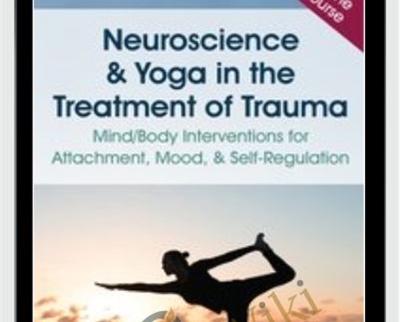Neuroscience and Yoga in the Treatment of Trauma: Mind/Body Interventions for Attachment, Mood, and Self-Regulation – Irina Diyankova and Debra Premashakti Alvis
$149.99 Original price was: $149.99.$39.00Current price is: $39.00.
Neuroscience and Yoga in the Treatment of Trauma: Mind/Body Interventions for Attachment, Mood, and Self-Regulation – Irina Diyankova and Debra Premashakti…
Salepage link: At HERE. Archive:
Adding this one thing to your talk therapy practice can fast-track the healing process for trauma survivors
Do you sometimes feel like your trauma clients are stubborn and unwilling to change?
They make little to no progress in their treatment…
Even though you see them consistently and use the talk therapy tools that you know work.
This is a common frustration with therapists. And clients.
You see, your clients WANT to get better…
But they can’t do it with talk therapy alone.
Trauma is more than psychological. It’s physical
The last two decades of neuroscience research proves trauma is stored in the body.
Trauma rewires the nervous system…
Keeping survivors’ bodies stuck in an exhausting state of fight, where they feel “keyed up,” anxious and overreact to sudden loud noises or crowds.
Or, they’re stuck in flight mode, characterized by emotional numbing, depression and disassociation from their bodies.
These torturous somatic responses can dominate the body for years after the traumatic event has ended…
Making your clients feel like strangers in their own bodies.
They have the desire and motivation to heal…
But without addressing trauma at the physical level, they’ll always be stuck in that post-traumatic state.
For clients to be at peace, you must help them release the physical trauma and once again befriend their body.
Discover the ancient practice savvy therapists use to help their clients break free from the crippling grip of trauma…
…Faster and easier than with talk therapy alone
Talking alone cannot discharge stored emotional memory.
Mindful movement, such as yoga, is required to release that stored energy and re-establish the mind-body connection…
And you don’t have to be a certified yoga professional—or have super flexibility—to get these benefits in your practice.
All you need to get started is this new online course!
You’ll get step-by-step instructions to help you integrate yoga as an essential—and effective—part of your client’s healing plan.
What Is Yoga and Why Is It Useful in Your Practice?
People across the world have been practicing yoga for more than 5 millennia. This is no fad movement.
Yoga practitioners use breathwork, mindfulness and physical poses to connect the breath, body and mind to turn the attention inward.
This allows a person to recognize habitual thought patterns and cultivate moment-to-moment awareness – which are essential elements of healing.
Why Yoga Is Effective in Trauma Treatment
Yoga helps trauma survivors to:
- Soothe their anxious minds so they engage in the present moment and tune into their bodies
- Empower themselves to make choices, which trauma often strips from survivors
- Create a positive, compassionate relationship with their body, mind and self
- Discover and use tools for self-regulation and processing sensations and emotions
- Release stored trauma memories so their brain and nervous system can regulate
- Live safely in their bodies in the present
- And much more
A recent study of women with chronic, treatment-resistant PTSD revealed that yoga:
- Significantly reduced the severity of PTSD symptoms,
- Reduced the incidence of self-harm activities,
- Decreased dissociative and depressive symptoms, and
- Increased the likelihood of loss of PTSD diagnosis
And this all happened after just 10 yoga sessions.
Long-term follow-up of the study revealed that an ongoing yoga practice helped to maintain these benefits.
Now you can incorporate elements of this ancient practice into your clinical work to help your clients finally break free from the immobilizing grip of trauma.
All you need to get started is the revolutionary new course:
In this course, you’ll discover the neuroscience behind yoga as an effective treatment for trauma AND practical exercises and applications you can start using immediately.
PART 1: Neuroscience & Yoga in the Treatment of Trauma
Section I: Neuroscience, Trauma and Yoga
Seated Yoga Grounding Practice to Relax and Focus
- How your clients experience yoga in the body
- How to quickly apply this practice to your work with trauma survivors
What Is Trauma?
- Psychological/emotional trauma
- Single vs. repeated vs. extended trauma
- Developmental trauma
- Complex trauma
What Neuroscience Tells Us about the Impact of Trauma
- How and why the brain and nervous system get “stuck” when trying to process a traumatic event
- Why a survivor’s post-trauma autonomic nervous system (ANS) creates narrow “windows of tolerance”—and how yoga can help widen them
- Simple sitting and standing yoga poses and their clinical applications
- Brain structures implicated in trauma and PTSD
- How trauma changes the brain and nervous system—and how they can heal
Section II: Intersections of Yoga and Trauma Treatment
Yoga Poses You Can Use in Individual and Group Work with Trauma Survivors
- Mountain Pose to come into the present and release negative emotions
- Forward Fold soothes an anxious nervous system and encourages introspection
- Breath of Joy boosts mood and reduces fatigue and depression
- Moving Warrior Poses help to heal shame and increase a sense of control in the body
- Dancing Tree Pose encourages balance in the body, which can be difficult for trauma survivors because of changes in their nervous system
- And more!
What Makes Yoga Suitable for the Treatment of Trauma
- The triune brain and how yoga calms the amygdala and sympathetic nervous system
- How yoga encourages both top-down and bottom-up regulation
- What yoga is—and is not—and how it can be applied clinically
- Debunking myths and misconceptions about yoga and who it’s for
- Research findings on yoga in the treatment of trauma
- Specific things to pay attention to when using yoga in treating a trauma survivor
- Integrating trauma-sensitive yoga in clinical work
PART 2: Bringing Trauma-Informed Yoga into Mental Health Clinical Practices
SECTION I: Using Somatic Experiencing in Your Practice
How Mindfulness and Yoga Can Help Your Clients
- What are “bells of mindfulness”
- How to keep you—and your clients—in the present moment
Yoga for Trauma
- Where the research on yoga and trauma stands right now
- Why yoga as a mind-body-spirit approach is so helpful in treating trauma
- How to work with yoga teachers to help clients develop an effective practice in conjunction with clinical treatment
Yogic Tradition and Neuropsychology
- The (short) history and purpose of yoga
- How trauma—and yoga—affects people at the cellular level
- Yoga’s effect on heart rate variability (HRV)
- How yoga improves vagal nerve tone to improve resiliency
Embodied Psychotherapy and Somatic Experiencing
- How somatic therapy through yoga can stabilize the ANS to reduce anxiety, depression and chronic stress
- What is “shock structure” and how it relates to trauma
- How yoga can increase positive experiences in trauma survivors
- Discover strategies that discharge the nervous system and restore a resting baseline in trauma survivors
- How trauma-sensitive yoga differs from other kinds of yoga
- Breathwork to help calm rising panic
SECTION II: Trauma-Informed Yoga in Action
Yoga and Self-Regulation
- What the research reveals about how yoga and breathwork helps trauma survivors
- Use yogic breathwork to calm and regulate the ANS
- Examples of yogic breathing exercises you can use with your clients
Applying Trauma-Informed Yoga Postures in Your Practice
- How to use and apply the principles and practices of trauma-informed yoga
- Chair yoga sequences that help your clients discharge trauma in their body
- How the deep relaxation of yoga nidra can help regulate the ANS
- Evaluating your clients to ensure this type of treatment is appropriate
- Suggestions for opening a nd closing sessions with trauma survivors
You’ll also receive clear, written instructions for all postures and breathwork used throughout the course.
Here's an overview of the prominent keywords and a list of famous authors:
Business and Sales: Explore business strategies, sales skills, entrepreneurship, and brand-building from authors like Joe Wicks, Jillian Michaels, and Tony Horton.
Sports and Fitness: Enhance athleticism, improve health and fitness with guidance from experts like Shaun T, Kayla Itsines, and Yoga with Adriene.
Personal Development: Develop communication skills, time management, creative thinking, and enhance self-awareness from authors like Gretchen Rubin, Simon Sinek, and Marie Kondo.
Technology and Coding: Learn about artificial intelligence, data analytics, programming, and blockchain technology from thought leaders like Neil deGrasse Tyson, Amy Cuddy, and Malcolm Gladwell.
Lifestyle and Wellness: Discover courses on holistic health, yoga, and healthy living from authors like Elizabeth Gilbert, Bill Nye, and Tracy Anderson.
Art and Creativity: Explore the world of art, creativity, and painting with guidance from renowned artists like Bob Ross and others.
All the courses on WSOlib are led by top authors and experts in their respective fields. Rest assured that the knowledge and skills you acquire are reliable and highly applicable.
Specification: Neuroscience and Yoga in the Treatment of Trauma: Mind/Body Interventions for Attachment, Mood, and Self-Regulation – Irina Diyankova and Debra Premashakti Alvis
|
User Reviews
Only logged in customers who have purchased this product may leave a review.
$149.99 Original price was: $149.99.$39.00Current price is: $39.00.
Related Products

Shaun T- T25 Focus – Gamma Pack

Male Physique Training Templates – Renaissance Periodization

Love or Above – Christie Marie Sheldon

Secrets Of the Shoulder – Gray Cook

Secrets of Sinawali – Joseph Simonet and Addy Hernandez

$149.99 Original price was: $149.99.$39.00Current price is: $39.00.







There are no reviews yet.